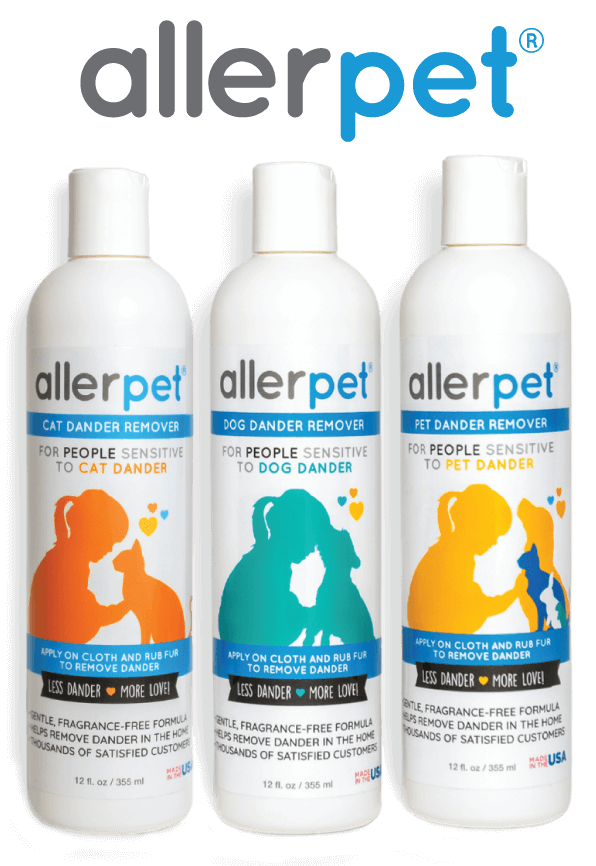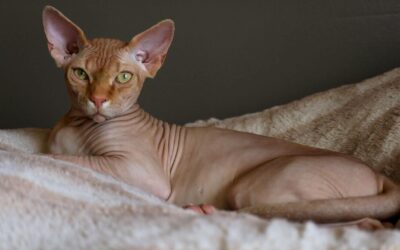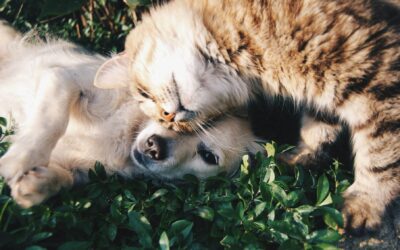Care & Habitat For Your Dogs & Cats
Introduction
All dogs and cats, regardless of hair length, need to be groomed on a regular basis, not only to keep them looking attractive, but also… and more importantly for allergy sufferers… to minimize the pet-related allergens that trigger reactions. Certain dog breeds require complex trimming at regular intervals. While most owners usually pay professionals do these jobs, allergic owners absolutely should employ others for this service.
Between professional appointments, or for dogs or cats that are not professionally trimmed on a regular basis, the following procedures describing the correct ways to brush, comb and clean the hair will help decrease the dispersal of pet allergens in your home.
Brushing And Combing
Brushing and combing a pet regularly is one of the most important steps to keep the skin and hair in good condition. For allergy sufferers, brushing at least once a week is essential because doing so removes dander, dirt, foreign matter, and loose dead hairs that are contaminated with dried salivary, sebaceous gland and urinary secretions and keeps them from shedding into the air and circulating throughout your home.
The sooner you start a regular brushing/combing routine, the easier it will be to get your pet accustomed to the process. There are many different types and textures of dog and cat hair, each type has its specific requirements when it comes to selecting the right brush and comb. Your pet supplies dealer can recommend the right tools, as can the breeder from whom you purchased your pet.
If you are allergic, let a family member do the brushing and combing, if possible. Otherwise, use a protective mask rated N95 or higher. Begin by adding some water to a spray bottle and lightly moistening your pet’s hair. Brushing dry hair increases the chances that dander and loose contaminated hair will blow into the air.
Your goal is to brush all the way down to the skin, not just on the top of the coat, to loosen and remove dander and dead hair. While this is simple to do on smooth-coated and short-haired dogs and cats, more effort is necessary when the hair is longer. In this case, you want to use your fingers to separate the hair into small sections.
Holding the unbrushed hair out of the way with your free hand, you want to brush each section from the skin outward with long, sweeping motions. After completely brushing the hair, comb through the coat to check that all loose hair has come out and that there are no tangles. As previously advised, remove the hair that has collected in the brush and deposit it into a nearby waste basket. Wash the brush and comb at the end of each session and change your clothes.
Shedding
When dogs and/or cats shed heavily, you must try to prevent the dead hair from piling up throughout your house. While there are no “hypoallergenic” breeds, people often have more problems with pets that shed profusely because of the excessive amount of loose hair – contaminated with pet allergens – that sheds off the pet and onto your upholstered furniture, carpets and clothing.
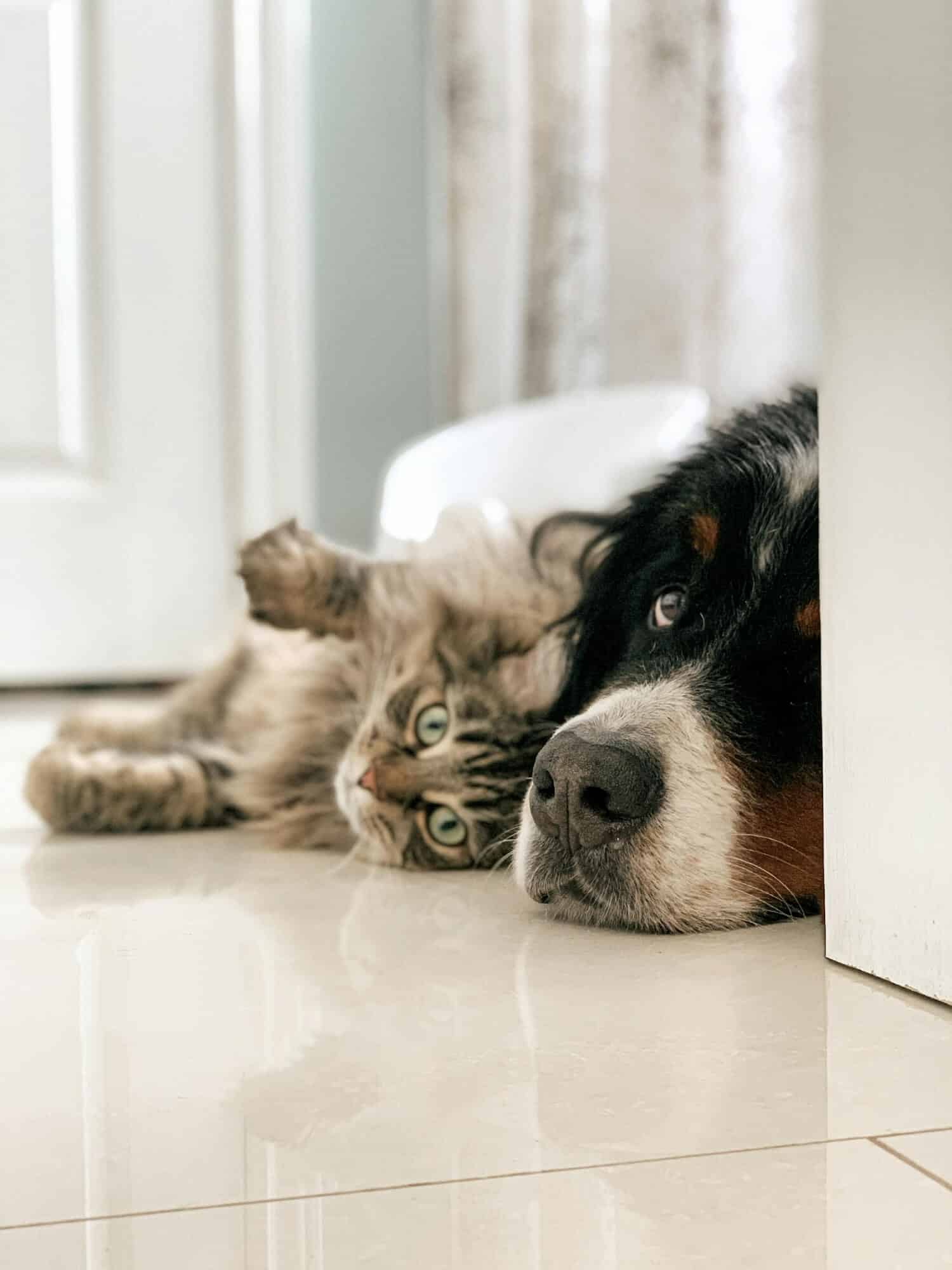
When this happens, especially on densely double-coated breeds (dogs with a soft undercoat and a coarser topcoat) such as German Shepherds, Akitas, Collies, Shelties, Samoyeds, and others, the undercoat loosens and starts coming out in fist-sized chunks.
Persians and other long-haired cats also shed profusely. You can help nature along by removing as much loose dead hair as possible, especially in the spring, before it covers everything in your house! In addition to a brush, a washable grooming glove is very helpful. Various kinds, with flexible rubber tips or plastic nibs, help to grab and remove loose dead hair.
You can also reduce your sensitivities to your pet by bathing or by wiping the pet’s coat with Allerpet Dog Dander Remover or Allerpet Cat Dander Remover once a week.
Bathing Advice
You can also reduce your sensitivities to your pet by bathing or by wiping the pet’s coat with Allerpet Dog Dander Remover or Allerpet Cat Dander Remover once a week. Bathing does reduce the amount of allergens, but the results are only temporary. A recent study found that the reduction didn’t last longer than a week. However, the earlier in life a dog or especially a cat becomes used to a bath, the better the chances of having it accept the process without becoming panic-stricken. If it’s already been a traumatic process to wash your cat, wiping over the coat with Allerpet Cat Dander Remover can be a happy alternative for both you and the cat.
Where you bathe depends on your pet’s size: bath tub, laundry tub, sink or shower stall. Pets usually become nervous when they are placed onto a slippery surface; a rubber mat or non-skid strips on the tub or sink bottom will secure footing and ease tension. To protect yourself from your cat’s claws, wrap a few strips of non-stick surgical tape around the paws so the claws cannot be extended.
Collect all the supplies you will need in advance: plastic cup or spray attachment for wetting, hypoallergenic shampoo, crème rinse or conditioner (for long-haired pets) and several fluffy towels. Don’t use a human shampoo; select one that is pH balanced for pets, as both dogs and cats have more alkaline skin and hair, and don’t use a dish washing liquid.
Always brush and comb your pet before the bath. Bathing tangled hair only makes matters worse as shampoo residue, dead hair and pet allergens get trapped in the tangles and are nearly impossible to rinse out.
Giving The Bath
If you are bathing a dog: turn on the water and when it runs consistently warm (not hot), stand the animal in the tub. If you are bathing a cat: fill a large plastic dishpan or the sink with about two inches of warm water, add a little shampoo, swirl it around with your fingers and then put in the cat. Bathing some cats for the first time is a job for two people – one to hold and control, the other to wet, shampoo and rinse.
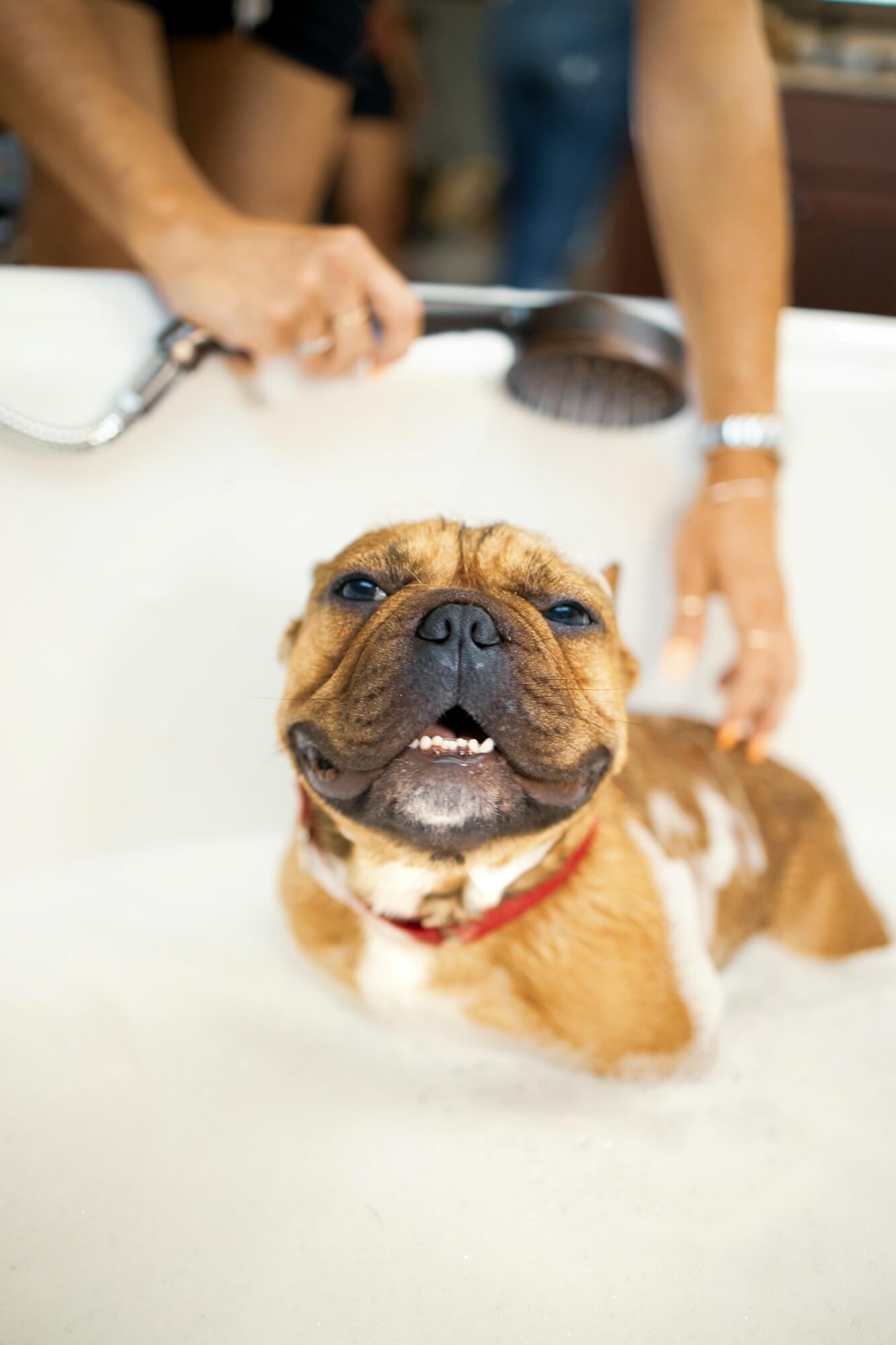
Do always face the cat away from you so that if it tries to escape, it will leap up and try to claw the air, not you. Using a nylon harness and leash also acts as a good restraint.
Wet the pet’s hair thoroughly all over, except for the head and ears, either pressing the sprayer directly against the coat to propel the water down to the skin, or pour the water over the coat with a plastic cup to remove as much dirt and loose dander as possible. It takes time to wet animal hair, especially pets with thick, almost water-resistant coats.
Bathing a dog or cat is like bathing a baby. Speak lovingly and reassuringly as you work, praising your pet and saying its name often. Shampoo the hair from back to front. Wet the head and wash it last. Take care not to get shampoo into the eyes (use a tearless shampoo if your pet is fussy or unruly). Use a washcloth to clean the face. If your pet is dirty or has long hair, rinse lightly and shampoo a second time to make sure the skin and hair are extra clean.
Rinsing And Drying
Begin the final rinse at the head, then spray or pour water down the neck, back, over the sides of the body, down the legs and feet and over the tail. Hold the spray nozzle or cup close to the skin and rinse thoroughly to remove all traces of shampoo and, more importantly, all loose dander, Fel d1 and urine residue. Squeeze the excess water from the hair, wrap the pet in a towel and take it out of the tub.
Keep pressing the coat with dry towels to remove as much excess moisture as possible. Keep your pet in a warm area, away from drafts, until the hair is completely dry. You may want to use a hair dryer if your pet has a long or thick coat. Wear a mask if you plan to fluff-dry the hair. Launder all towels used in the process.
Using Allerpet in place of a bath (and in-between baths) is an effective and much less aggravating way to remove allergens from a dog’s or cat’s coat and skin.
Using Allerpet
Using Allerpet in place of a bath (and in-between baths) is an effective and much less aggravating way to remove allergens from a dog’s or cat’s coat and skin. Allerpet can be applied one or two times a week. If your pet is small, wipe it on while the dog or cat sits in your lap. Just spread a large, clean terry towel over your lap for your pet to sit on. This will keep you dry and prevent hair from shedding onto your clothes.
1. Dampen a washcloth or microfiber cloth and lightly wipe your pet from the skin outward, first against the lay of hair, then with it, until all areas are damp, not dripping wet, to remove dander and dried saliva and urine. Wipe several times over any areas your pet licks most often: around the genitals, for instance, where urine tends to collect and dry on the hair, especially on males. No rinsing is required.
2. Dry the hair thoroughly with a towel or hair dryer (caution: a hair dryer can badly scare a cat). Launder your grooming clothes and towels used in the process.
Cat Litter
The dust from traditional coarse-grained clay cat litter can aggravate allergies. Unscented litter is, by and large, less irritating than brands with strongly scented perfumes, deodorizers or other additives. Better choices for allergy sufferers would be clumping litter (virtually dust-free), litter pearls or all-natural litters made from a variety of substances that come in pellet, flake and granule form, like World’s Best Cat Litter (made from corn/corn cob), Feline Pine (100% pure pine), Swheat Scoop (wheat), and Yesterday’s News (recycled newspaper). Clumping litters are composed of fine sandy granules which expand and completely absorb all urinary waste by forming easy-to-remove clumps. No liquid reaches the bottom of the litter; the tray stays clean and smells fresh longer. Natural litters, too, are highly absorbent and soak up liquid like a sponge.
Try various brands to find one that produces the least amount of dust or best suits your lifestyle. When possible, a non-allergic family member should scoop and clean the box; otherwise the allergy sufferer should wear a protective mask when changing the litter, pouring it into the pan slowly to keep dust from permeating the air. A good quality litter should help to minimize odor. Scooping the box daily and cleaning it regularly are the most effective ways to control odor.


